![]()
![]()
![]()
Use LEFT and RIGHT arrow keys to navigate between flashcards;
Use UP and DOWN arrow keys to flip the card;
H to show hint;
A reads text to speech;
66 Cards in this Set
- Front
- Back
|
PVC |
Weird fat QRS |
|
|
The heart contacting is |
Depolarization |
|
|
The heart beating too fast is |
Tachycardia |
|
|
We read the ___ of the heart on the monitor not ___ |
Electrical Activity Muscular activity |
|
|
Normal heat rate is |
60 - 100 bpm |
|
|
Repolarization is |
The heart resting |
|
|
An interval is |
A time between 2 specific events PR interval QRS interval QT interval RR interval |
|
|
1 small box is |
.04 seconds |
|
|
5 small boxes is |
.2 seconds |
|
|
5 large boxes is |
1 second |
|
|
A normal strip is |
6 seconds |
|
|
A P wave represents |
The contraction of the atria |
|
|
The T wave is |
The repolarization (resting) of the heart |
|
|
The QRS is |
The contraction of the ventricle |
|
|
A normal PR interval is |
3-5 boxes |
|
|
A normal QRS interval is |
1-3 boxes |
|
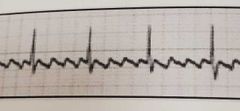
|
Atrial flutter |
|
|
SVT have ___ P waves, indicated by a ___ |
Hidden
Narrow QRS |
|
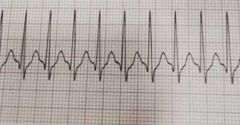
|
Supraventricular Tachycardia
(Notice the narrow QRS, so there IS a P wave) (Tachycardia with hidden P's, >150 bpm) |
|
|
What are the Premature beats |
PAC Premature Artial contraction
PJC " " junctional contraction
PVC " " ventricular contraction |
|
|
PAC stands for ___ And effects the ___ |
Premature Artial Contractions P wave |
|

|
PAC
(The P wave is Upright but weird) |
|
|
A PJC affects the ____ It will be ____ |
P wave Flat or inverted |
|

|
PJC Premature Junctional contraction
(Flat / Inverted P wave) |
|
|
No P wave will make a QRS ___ |
Wide |
|

|
PVC
(No P wave, so wide QRS) |
|
|
PVC patterns |
Ventricular Bi/ tri/ quadrigeminy Couplets Runs of Ventricular tachycardia
|
|
|
Runs of ventricular tachycardia |
3 or more PVC's in a row |
|

|
Wandering Artial Pacemaker (WAP) |
|
|
WAP's have |
At least 3 different P waves Even flat ones |
|
|
What are the 6 lethal rhythms |
Ventricular tachycardia (V tach) Ventricular fibrillation (V fib) Torsades de pointes Idioventricular rhythm Accelerated Idioventricular rhythm Asystole |
|

|
Ventricular tachycardia |
|
|
V tach has |
No P wave
Wide QRS
101-250 bpm |
|
|
V fib indicates that a pt is |
"Clinically dead" |
|

|
Ventricular fibrillation |
|
|
Torsades de pointe are usually ___ bpm |
150-250 bpm |
|

|
Torsades de pointe |
|
|
Idioventricular rhythm has |
No P wave (so a wide QRS)
Is very slow! 20-40 bpm |
|

|
Idioventricular rhythm 20 - 40 bpm
|
|
|
Accelerated Idioventricular rhythms are |
41-100 bpm
No P wave, thus, a wide QRS |
|

|
Accelerated Idioventricular rhythm
41- 100 bpm |
|
|
Junctional rhythm is |
Slow
40-60 bpm |
|
|
Junctional rhythms have
____ P waves
|
Flat (hidden) or inverted P waves
This is indicated by a normal QRS.
|
|
|
Junctional rhythms are classified by their ___ |
Rate |
|

|
Junctional rhythm
(Looks like Idioventricular rhythm but the QRS is narrow) 40-60 bpm |
|
|
There are ___ types of "fast" junctional rhythms |
2
Accelerated junctional rhythm &
junctional tachycardia |
|
|
Accelerated junctional rhythms are |
61-100 |
|

|
Accelerated junctional rhythm 61-100 bpm |
|
|
Junctional tachycardia is |
100- 150 |
|
|
Junctional tachycardia > 150 is considered |
SVT |
|
|
A bundle branch block is |
A delay or obstruction along electrical pathway on the right or left of the ventricles |
|
|
A wide or slurred S wave indicates a |
Right bundle branch block (The effect of an old heart attack) |
|
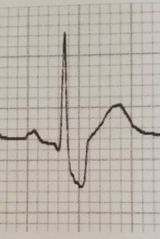
|
Right bundle branch block |
|
|
This bundle block has an "M" shape or notched R waves |
Left bundle branch block |
|
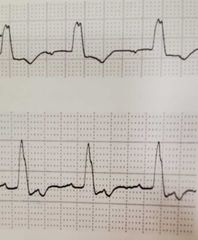
|
Left bundle branch block |
|
|
The 3 paced rhythms |
Atrial pacemaker
Ventricular pacemaker
Atrioventricular pacemaker |
|

|
Junctional Tachycardia 100- 150 |
|

|
Atrioventricular Paced Rhythm (The spike is in the P wave for Atrial paced The spike will be in the QRS for a V. Paced) |
|
|
This characterizes a 1st degree heart block |
Elongated PR interval (Longer than 3-5 boxes) |
|
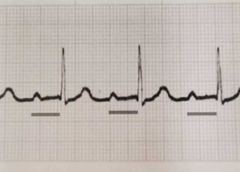
|
1st degree heart block |
|
|
2nd degree heart blocks deal with ____ |
Missing QRS's |
|

|
Ventricular Paced Rhythm |
|
|
Arrhythmia |
P wave Irregular R to R |
|
|
A fib |
NO P wave Irregular |
|
|
If QRS is Larger than .12 it is a |
BBB |
|
|
Qrs over _____ is a BBB |
.10 |

